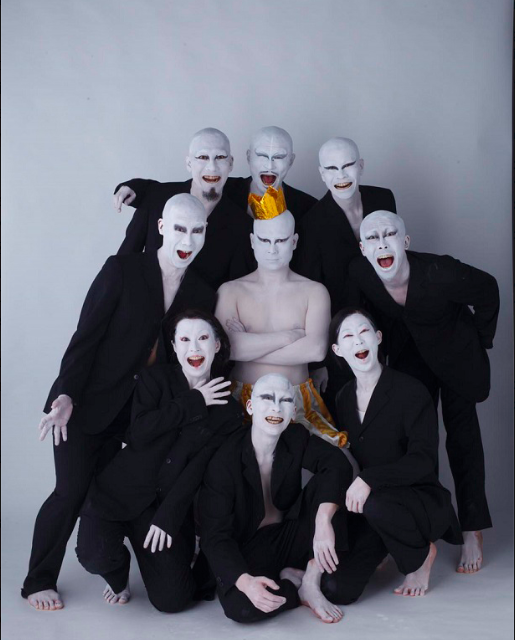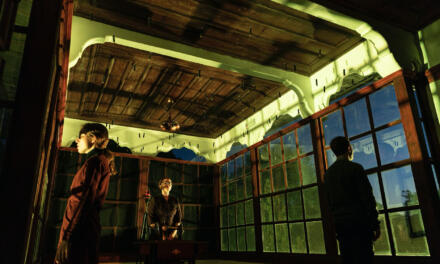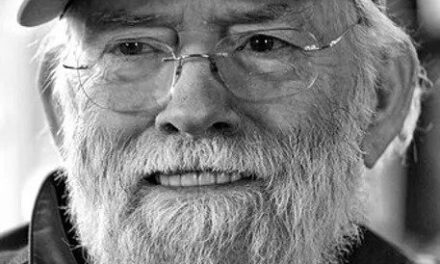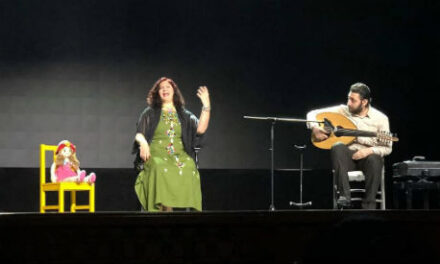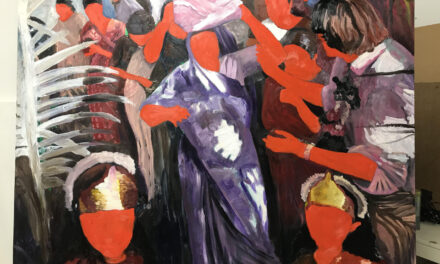“Gloomy,” “eerie,” “vulgar,” “avant-garde” and “conceptual” are adjectives often used to describe butoh, the genre of Japanese modern dance started in 1959 by Tatsumi Hishikata and Kazuo Ohno in which performers usually paint their near-naked bodies white.
In contrast, Ikko Tamura — a core member of the leading butoh troupe Dairakudakan (Great Camel Ship) founded in 1972 by iconic artist Akaji Maro — is now working with others from the company on a show that may push butoh’s adjectival envelope to include words such as “friendly,” “fun” or even “pop.”
“I am trying to be free from conventional ideas of a children’s performance,” the 40-year-old dancer and choreographer who joined Dairakudakan in 1998 told me as we sat in its small studio in Kichijoji, western Tokyo, and talked about his new work — an hourlong butoh adaptation of Hans Christian Andersen’s The Emperor’s New Clothes that the Owl Spot public theater in Toshima Ward, Tokyo, asked him to create for children.
In the short fable, two conmen tell a vain emperor who’s mad about clothes that they can make him the finest-ever suit from a fabric that’s invisible to anyone who’s unfit for their position, or just plain stupid. The emperor (played by Tamura) is thrilled, and soon the pair return — with an empty parcel — and after the emperor takes off all his clothes they mime dressing him in the suit.
Of course, none of his ministers can see the suit, but they all pretend to admire it for fear of losing their positions — and the stupid emperor basks in their flattery. The townsfolk, too, maintain the dishonest charade when their preening but naked monarch appears in a procession — until a child innocently yells “He’s got no clothes on!” and they all wildly take up the cry.
Though Tamura said he intentionally avoided making his work simplistic or pantomime-like, on the other hand, he stressed that he was keen to avoid creating something too taxing for young audiences likely seeing their first-ever butoh that he hopes they’ll enjoy rather than endure — and become fans of the future.
Consequently, he said he focused on creating a fast-flowing piece that told a clear story and included comical movements, adding, “Butoh’s usually a mime, but I even plan to say some words to help them understand the story smoothly in the dance performance.
“As I tell everyone, though, there are no rules or taboos in butoh, so dancers are free to make any facial expressions and do any movements.”
Meanwhile, besides dancing with Dairakudakan, in recent years Tamura has also been running butoh workshops for all kinds of people from kids to oldies, factory workers, office types and people with disabilities throughout Japan.
“But my workshops aren’t aimed at fostering professional butoh dancers, or teaching butoh skills and techniques,” he explained. “Rather, I would like to tell them just how interesting humans’ bodies are — and how much pleasure they can have by expressing themselves through butoh or other dance forms.
“However, the butoh method’s special great merit is that it’s concerned with the very basic matter of bodies — and they are common to anyone from young to old.
“So, for example, I don’t teach hip-hop steps or movements, but I might ask the children or others to ‘stand as you like, feel the wind and sway and rustle like a tree.’
“Then they can sense their bodies precisely and find out about them through trying to do that.
“Hence in my workshops I would like to introduce a new aspect of dance that’s not just about hard exercise, and I want to present real freedom of expression and freedom in ways of living through butoh — which, after all, accepts any style of expression.”
Then, returning from the general to the particular, Tamura said, “I am so happy to be given this theme of ‘The Emperor’s New Clothes,’ which I would never choose by myself, as I think it’s very important to listen to others and be open to different ideas and opinions from outside.”
Indeed, all the time he’s traveling for his workshops, or with Dairakudakan, he said he’s constantly meeting new people, getting ideas and making unexpected discoveries that gave him energy and fuel his imagination to enrich his own creations.
“Through meeting others, I recognize more about myself, and being able to watch myself from the outside like that also refers to this fable. I would like to examine that point through this new work.”
Then, when our interview ended and Tamura and the other dancers began rehearsing to the energetic music of The William Tell Overture, springing and spinning into fast-flowing life just as he’d said they would, it was wonderfully clear that they would soon be casting a new bright light on the much-maligned “gloomy” butoh world.
This post originally appeared on The Japan Times on July 26, 2016, and has been reposted with permission.
This post was written by the author in their personal capacity.The opinions expressed in this article are the author’s own and do not reflect the view of The Theatre Times, their staff or collaborators.
This post was written by Nobuko Tanaka.
The views expressed here belong to the author and do not necessarily reflect our views and opinions.

